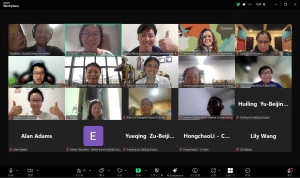Community organizations refer to non-profit organizations that operate in local communities with local residents making up their members and receiving their services. The organizations are voluntary, autonomous and operated on a non-profit basis. Whether community organizations can achieve these functions relies on their governance capacity, which NGOs can help improve.
Based on experience and the principle of focusing on problem-solving, the practitioners at the Beijing Facilitators, an NGO which has been assisting in building community organizations since 2013, summarized four ways NGO work can improve community organizations.
Firstly, NGO work can bring out the potential of community organizations. In some places, community organizations are still at the stage of declarative building, where resources are spent on hanging up signs and creating rosters but not on fostering community residents’ awareness and ability to participate in community work.
NGO work usually divides resident participation into five stages: informing, consulting, negotiating, joint action, and community autonomy. In this model, NGOs can promote participation by nurturing and improving residents’ willingness and ability to participate, while increasing the value of their participation.
Secondly, NGOs’ ability to promote development should be brought into play to solve the problem of community organizations lacking regulatory guidance and technical support. This problem often results in community organizations being self-perpetuating, making it difficult for them to grow bigger.
The majority of community organization members lack knowledge and skills in terms of organizational governance and project management. NGOs, therefore, can enhance the professional knowledge and skills of key community members in organization governance, project management and volunteer management through supervision and workshops, so that the standardized development of community organizations can be guaranteed.
Thirdly, NGOs can integrate different resources to solve the lack and low efficiency of resources in community organizations. Community organizations mainly use community resources which at present are scarce. This problem indicates the lack of awareness and ability to link resources in community organizations.
NGOs place considerable emphasis on exploring, utilizing and integrating internal and external resources in the community, building formal and informal support networks, and building social capital by promoting solidarity, all of which can help community organizations survive and better serve their service users.
Lastly, NGOs can provide professional assessments to help address the difficulties experienced by community organizations in responding to community needs and lack of participation. Due to the lack of work assessment, many community organizations either work based on how they feel about tasks or are stuck with doing whatever the community council says, which makes it hard to meet the diverse needs of residents in a sustainable fashion. From demand to process and outcome assessment, NGOs have developed a set of scientific and practical assessment methods, with a focus on the participation of service recipients.
How should NGOs get involved
There are three paths for NGOs to nurture community organizations. The first path is to provide direct services to communities. For instance, in response to the lack of support for empty-nest elders (refers to senior citizens whose children are not around to take care of them) in the community, NGO workers can lead community volunteers to provide care services and identify and mobilize younger empty nesters who have the will and ability to participate in voluntary services for the elderly. This also enhances the engagement of younger empty nesters, helping them to gain a sense of self-efficacy.
As mentioned above, one of the challenges faced by community organizations is a lack of resources. In China, besides the type of community organizations this article has been discussing, which are set up by community residents voluntarily, there is another type which is established with a top-down approach by government departments. NGOs can channel resources from top-down organizations to community organizations to develop their full potential.
The third path is to build platforms for long-term development and organization incubation. The Beijing Facilitators works in tandem with other NGO incubation platforms to promote the development of community organizations.



